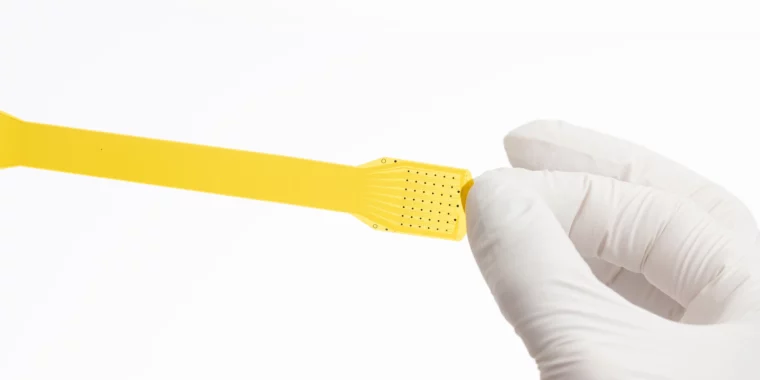Brain-computer interface company Precision Neuroscience says it has set a new world record for the most neuron-tapping electrodes placed in a living human brain: 4,096, beating last year’s previous record of 2,048. The company announced this on Tuesday.
High density electrodes will allow neuroscientists to map neuronal activity with unprecedented resolution, ultimately improving our ability to decipher thoughts into intended actions.
Like many of its rivals, Precision’s immediate goal is to use brain-computer interfaces (BCIs) to restore speech and motor skills, particularly to patients who have suffered strokes or spinal cord injuries. But what sets Precision apart from its competitors is that it spun out from one of the best-known BCI companies, Neuralink, owned by the controversial billionaire Elon Musk.
Precision was co-founded in 2016 by neurosurgeon and engineer Ben Rapoport, who was also a co-founder of Neuralink. Rapoport later left the company to start rival Precision in 2021 with three colleagues, two of whom were also involved with Neuralink.
On the May 3 episode of The Wall Street Journal’s podcast “The Future of Everything,” Rapoport said: He left Neuralink over safety concerns For the company’s more invasive BCI implants.
In moving neural interfaces from the scientific world to the medical world, “safety is paramount,” Rapoport said. “For medical devices, safety often means being minimally invasive,” he added. Rapoport said that in the early stages of BCI development, Utah Alley“The idea was that to extract information-rich data from the brain, you had to stick tiny needle-like electrodes into the brain,” he says, “and those electrodes have the drawback of causing some degree of brain damage when they’re inserted into the brain. I felt it was possible to extract information-rich data from the brain without damaging it.” Precision was founded with this philosophy in mind: minimally invasive, scalable, and safe, he says.
Neuralink’s current BCI device has 1,024 electrodes attached to 64 hair-thin wires that are implanted into the brain by a surgical robot. In the first patient to receive the implant, the wires were inserted 3 to 5 millimeters into brain tissue. But within a few weeks of the procedure, 85 percent of the wires had retracted from the patient’s brain, and some electrodes had become dislodged and disconnected. Neuralink reportedly plans to implant the wires deeper — 8 millimeters — in the second patient. The Food and Drug Administration has reportedly approved the procedure. The Utah array, by contrast, can penetrate up to 1.5 millimeters into the brain.
Precision’s device does not penetrate the brain at all, but rests on top of it. The device contains at least one yellow film, said to be one-fifth the thickness of a human hair, and contains 1,024 electrodes embedded in a grid pattern. The device is modular, allowing multiple films to be added to each device. Precision says the film can be slipped into the brain through a minimally invasive procedure that involves making a thin cut in the skull, through which the yellow ribbon-like device passes. The film then fits over the surface of the brain. The processing unit that collects data from the electrodes is placed between the skull and the scalp. If the implant needs to be removed, the film is designed to slide off without damaging the brain.
In April, a neurosurgery team at the Mount Sinai Health System attached a Precision device equipped with four sheets of electrode film (a total of 4,096 electrodes) to the brain of a patient undergoing surgery to remove a benign brain tumor. While the patient was asleep with his skull open, Precision researchers were able to use the four-electrode array to record detailed neural activity from an area of the brain measuring roughly 8 square centimeters.
“This recording marks an important step towards a new era,” Rapoport said in a press release Tuesday. “Capturing cortical information on this scale and in this volume will allow us to better understand the brain.”
The implant test marks Precision’s 14th time placing the device inside a human brain. According to CNBC:Precision, which witnessed the surgery in New York, says it expects to have its first devices commercially available in 2025.


